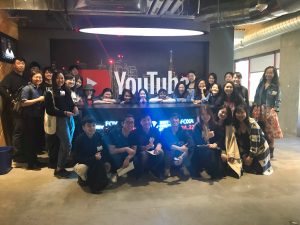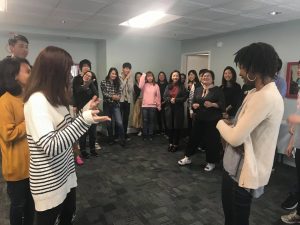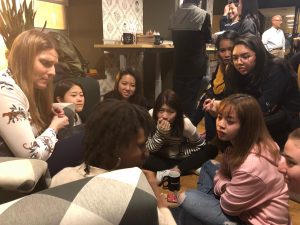
djkslf
Exploring Social Innovation – An Experience in Bay Area
Perhaps if one has never visited San Francisco, then one’s perception of Silicon Valley, San Francisco could be that of a community where people are productive, coughing up ideas every second to make profit and to change the world. The air would have atoms of innovation that could be clearly seen if one took a moment to look closely while breathing. The city will be futuristic displaying all the groundbreaking innovations that Silicon Valley has birthed till date. However, the reality is not always close to our imaginations.
Volunteers in Asia (VIA) is an organisation that provides innovative experiential learning programs to promote cross-cultural understanding, and one of its programs; Exploring Social Innovation, afforded me the opportunity to visit San Francisco and learn about the centre of innovation. A place where various social issues abound amidst the wealth creation Silicon Valley is known for. In discovering these issues, we were also able to learn about the social innovation happening within the city and use these models to solve social issues we are passionate about.
It was a ten days program where we had several lessons and activities on design thinking, storytelling, empathy building, social innovation discussions, volunteering and site visits. The beginning of the program got everyone to learn about one another and by learning about each other, we took a new step into an amazing future where we experienced different things with people from cross-cultural backgrounds. Learning storytelling methods and creating individual life-maps we discovered how people from different cultures struggle and rise up in different ways as well as in ways similar to our own experiences.
There was a panel discussion on the Trends in Social Innovation by Darlene Damm and Cynthia Ijaggi where Darlene Damm described projects being carried out currently in Singularity University such as Hands free hectare (no people farms), cellular growth of meat, robotic arms cook, gene therapy by Liz Parish for preventing aging, telepathy through brain to brain interfaces, self driving house-car, etc. and shared challenges still being faced with ethics, exclusion and economic issues. Cyntia Ijaggi discussed about Regenerative Capitalism which represents the restorative process to the economic system that is running without rest. She shared her belief that beyond sustainability is regenerative capitalism where there is shared abundance (mutual benefits across levels and systems), holistic view of wealth (includes health, relationships, etc.), and entrepreneurship (using tool of enterprise to innovate into solutions).
A key lesson during the program was empathy. The meaning of empathy was taught through games that allowed the participants to listen to stories and use their bodies (in a kind of posture) to emulate the feeling of empathy. Through these games one could really try to feel their partner’s emotions and understand what empathy means. The game of empathy was further extended to understanding the widening income gap and homelessness issue in San Francisco where no fault evictions cases are on the rise as more people move into the Bay area. In summary, Empathy I learnt requires curiosity to dig deep enough to be able to experience the situation in the mind clearly and feel the emotions stirred by it.
Empathy plays a major role in design thinking, an important tool for innovation which was one of the learning objectives of the program. We went through design thinking course by engaging in several projects. This training got everyone practicing the principles of design thinking; Empathize, Define, ideate, prototype and test; with a main goal of combining technology business and human factor and a mindset of growth, failure and grit, and iterations. In applying empathy, interviews were conducted on the streets around Civic Center and we were able to discover more about the community of San Francisco and how much the people love the place and its diversity in spite of the issues they were facing .
Site visits served as a fun and learning experience. We visited places like Youtube, Delancey Street, BayCat, Stanford d.school, Google Community Centre, Autodesk and even volunteered at Glide Memorial, a church that serves free food to the city’s homeless and hungry. An impressive visit was Delancey Street. It is said that while Harvard or Stanford takes the top 2% Delancey Street takes the bottom 2% in the society . Delancey Street is an alternative sentencing opportunity for those that had a jail sentence founded by Mimi Silvia in 1981. At Delancey Street, residents learn a different way of thinking, how to act, treat people, control themselves, do what is right and learn integrity for themselves. However more like a life-school than a prison, the residents work together as community to serve the society through various businesses such as moving company, restaurants, tailoring, etc. During the tour of the facility built by the residents, we learnt how much of an influence, the organisation has on the Bay Area. This tour threw another perspective to how to tackle social issues.
 The Youtube tour showed that the working culture is a flat management system where decisions are made quickly, everyone is trusted, innovation is quick, people feel free and comfortable. The working environment was impressive; open work space, no private cubicles, a lot of greenery both indoors and outdoors with the trees, glass walls, pictures and things to inspire creativity, play area, free idea boards, reading space with books, devices room for testing products. The Stanford d.school building tour was interesting; there were not so many rooms , walls could be moved and also served as whiteboards, some tables had writing surfaces and could move. Ideas of others are open for all to see to inspire others, every furniture is built by students. And the purpose of such a design space was to spark ideas and creativity.
The Youtube tour showed that the working culture is a flat management system where decisions are made quickly, everyone is trusted, innovation is quick, people feel free and comfortable. The working environment was impressive; open work space, no private cubicles, a lot of greenery both indoors and outdoors with the trees, glass walls, pictures and things to inspire creativity, play area, free idea boards, reading space with books, devices room for testing products. The Stanford d.school building tour was interesting; there were not so many rooms , walls could be moved and also served as whiteboards, some tables had writing surfaces and could move. Ideas of others are open for all to see to inspire others, every furniture is built by students. And the purpose of such a design space was to spark ideas and creativity.
All ten days of the program was a learning experience that reorientated our mindsets and showed us how much potential we had and could utilise to solve various problems in our societies. One key takeaway is the importance of empathy – design thinking – while working on different projects in our career. Being a part of a laboratory whose research is centred on human-approach, this program further expanded my knowledge on how how best to conduct my own research focused on inclusive communities within urban spaces.

